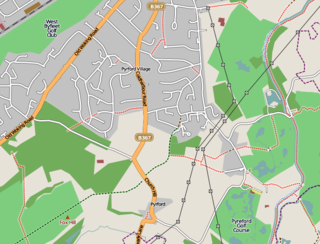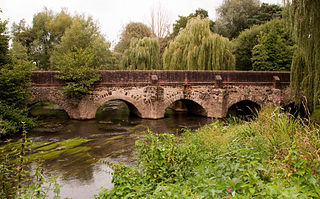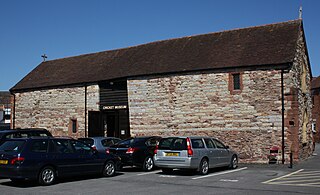
Gisborough Priory is a ruined Augustinian priory in Guisborough in the current borough of Redcar and Cleveland, North Yorkshire, England. It was founded in 1119 as the Priory of St Mary by the Norman feudal magnate Robert de Brus, also an ancestor of the Scottish king, Robert the Bruce. It became one of the richest monastic foundations in England with grants from the crown and bequests from de Brus, other nobles and gentry and local people of more modest means. Much of the Romanesque Norman priory was destroyed in a fire in 1289. It was rebuilt in the Gothic style on a grander scale over the following century. Its remains are regarded as among the finest surviving examples of early Gothic architecture in England.

Castle Acre Priory was a Cluniac priory in the village of Castle Acre, Norfolk, England, dedicated to St Mary, St Peter, and St Paul. It is thought to have been founded in 1089 by William de Warenne, 2nd Earl of Surrey. The order originated from Burgundy. Originally the priory was sited within the walls of Castle Acre Castle, but this proved too small and inconvenient for the monks; hence, the priory was relocated to the present site in the castle grounds about one year later.
In Christianity, a collegiate church is a church where the daily office of worship is maintained by a college of canons, a non-monastic or "secular" community of clergy, organised as a self-governing corporate body, headed by a dignitary bearing a title which may vary, such as dean or provost. In its governance and religious observance a collegiate church is similar in some respects to a cathedral, although a collegiate church is not the seat of a bishop and has no diocesan responsibilities. Collegiate churches have often been supported by endowments, including lands, or by tithe income from appropriated benefices. The church building commonly provides both distinct spaces for congregational worship and for the choir offices of the canons.

Ripley is a village and civil parish in Surrey, England. It is centred 6.2 miles (10.0 km) southeast of Woking, 6.8 miles (10.9 km) northeast of Guildford and 22.5 miles (36.2 km) southwest of London. Neighbouring villages Send and Send Marsh to the South-West and Ockham to the East have fewer shopping facilities.

Pyrford is a village in the borough of Woking in Surrey, England. It is on the left bank of the River Wey, around two miles east of the town of Woking and just south of West Byfleet; the M25 motorway is northeast of the edge of the former parish.

Merton Priory was an English Augustinian priory founded in 1114 by Gilbert Norman, Sheriff of Surrey under King Henry I (1100–1135). It was situated within the manor of Merton in the county of Surrey, in what is today the Colliers Wood area in the London Borough of Merton.

West Byfleet is a village in Surrey which grew up around its relatively minor stop on the London & South Western Railway: the station, originally Byfleet and Woodham, opened in 1887. More than 1 mile (1.6 km) from the medieval village of Byfleet, the initial concentration of a new development soon established its own economy apart from that of a dependent London commuter village and spread in most directions to its borders including to the border of the old settlement, divided by the shielded M25 motorway today. The first place of worship was dedicated in 1912, the parish of West Byfleet associated with it was established in 1917. The village is bounded to the north by the Basingstoke Canal and to the east by the M25 and the Wey Navigation Canal. Forming part of the contiguous development centred on London and its stockbroker belt just outside the M25 motorway, it is 18 miles from London Heathrow and equidistant between the business parks of Woking and Brooklands. In local government it forms a ward on the same basis as its parish in the Borough of Woking.

Edington Priory in Wiltshire, England, was founded by William Edington, the bishop of Winchester, in 1351 in his home village of Edington, about 3+3⁄4 miles (6 km) east of the town of Westbury. The priory church was consecrated in 1361 and continues in use as the parish church of Saint Mary, Saint Katharine and All Saints.

Mattersey Priory is a former monastery of the Gilbertine Order, located near the village of Mattersey, Nottinghamshire, England. It is managed by English Heritage.

The River Wey Navigation and Godalming Navigation together provide a 20-mile (32 km) continuous navigable route from the River Thames near Weybridge via Guildford to Godalming. Both waterways are in Surrey and are owned by the National Trust. The River Wey Navigation connects to the Basingstoke Canal at West Byfleet, and the Godalming Navigation to the Wey and Arun Canal near Shalford. The Navigations consist of both man-made canal cuts and adapted parts of the River Wey.
Haltemprice Priory was an Augustinian monastery approximately two miles south of the village of Cottingham in the East Riding of Yorkshire, England. The original monastic buildings have long since gone, although ruins of a farmhouse, built in 1584, remain on site and incorporate some of the Priory stonework.

Bradenstoke Priory was a medieval priory of Augustinian canons regular in the village of Bradenstoke, Wiltshire, England. Its site, in the north of the county about 1+1⁄2 miles (2.4 km) west of Lyneham, is on a ridge above the south side of Dauntsey Vale. In the 1930s the property was purchased by William Randolph Hearst and some of its structures were used by him for the renovation of St Donat's Castle near Llantwit Major, Wales.

The River Wey is a main tributary of the River Thames in south east England. Its two branches, one of which rises near Alton in Hampshire and the other in West Sussex to the south of Haslemere, join at Tilford in Surrey. Once combined the flow is eastwards then northwards via Godalming and Guildford to meet the Thames at Weybridge. Downstream the river forms the backdrop to Newark Priory and Brooklands. The Wey and Godalming Navigations were built in the 17th and 18th centuries, to create a navigable route from Godalming to the Thames.

Belmont Abbey, in Herefordshire, England, is a Catholic Benedictine monastery that forms part of the English Benedictine Congregation. It stands on a small hill overlooking the city of Hereford to the east, with views across to the Black Mountains in Wales to the west. The 19th century Abbey also serves as a parish church.

Taunton Priory, or the Priory of St Peter and St Paul, was an Augustinian house of canons founded c. 1115 by William Gyffarde, Bishop of Winchester and Chancellor of England near Taunton, Somerset, England.
William Kingsmill alias William Basyng (?–1549) was Prior of St. Swithun's Priory, Winchester until the Dissolution of the Monastery in 1539; it was a Benedictine monastic house and its shrine to the saint popularly associated with determining the entire period of pre-harvest weather was a place of pilgrimage. He was appointed as the first Dean of Winchester Cathedral at the foundation of the new chapter in 1541.

Woking is a town and borough in northwest Surrey, England, around 22 mi (35 km) from central London. It appears in Domesday Book as Wochinges and its name probably derives from that of a Saxon landowner. The earliest evidence of human activity is from the Paleolithic, but the low fertility of the sandy, local soils meant that the area was the least populated part of the county in 1086. Between the mid-17th and mid-19th centuries, new transport links were constructed, including the Wey Navigation, Basingstoke Canal and London to Southampton railway line. The modern town was established in the mid-1860s, as the London Necropolis Company began to sell surplus land surrounding the railway station for development.

Chilworth Manor is a historic country house located midway between Chilworth, Surrey and St Martha's Hill to the north. The manor is grade II listed by Historic England.

















